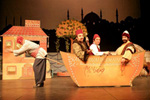 Ayyar Hamza Ayyar Hamza
I was fortunate to have seen a play called Ayyar Hamza that I will be talking about this week. But before I do that, I would like to give a little background information about the traditional example of early Turkish theater, the "theather-in- the-round" or in Turkish orta oyunu. The origins of this tradition go back to the early Anatolian Seljuks. It is based on oral conversations between characters that happen to be hilarious and educational at the same time. It is quite extraordinary in the sense that it uses some traditional musical instruments, such as the Darbuka and Tef, throughout. For example, when some one is walking on the stage, one of the characters hits the instrument at the same rhythm as the walking pace to stress the importance of the movements. As well, it is done in the open-air, (or if the weather conditions are bad, then indoors) inside of a circle. In early times, the "stage" was defined by stakes in the ground with strings pulled around them.
 Ayyar Hamza was one of the first by Ali Bey (who lived from 1844 until 1899 and is one of the founders of Turkish theater) and was adapted from French playwrite Jean Baptiste Poquelin de Moliere's play "The Impostures of Scapin." It was first staged in 1871 in the Ottoman theater. Ayyar Hamza was one of the first by Ali Bey (who lived from 1844 until 1899 and is one of the founders of Turkish theater) and was adapted from French playwrite Jean Baptiste Poquelin de Moliere's play "The Impostures of Scapin." It was first staged in 1871 in the Ottoman theater.
The play has not lost any of its value over time. Although it was written long ago, the humor is still there and is even better than most recent plays. According to the playbill, Ayyar Hamza is formed around the story of two fathers, two gentleman, two lost girls and two servants where the relationships are entangled creating clashes of love, class, father-son, servant-master, and rich-poor."
 This rich play incorporates it’s own unique language and also gives a visually appealing “mise-en-scene.” This setting is also influenced by Ottoman style drawings, such as miniatures. The successful actors and actresses performed the piece in such a way asto enchant the audience. This rich play incorporates it’s own unique language and also gives a visually appealing “mise-en-scene.” This setting is also influenced by Ottoman style drawings, such as miniatures. The successful actors and actresses performed the piece in such a way asto enchant the audience.
If you have any interest to theater I am sure you would enjoy this play.
I fare you well for now… Alev Dešim (COMD/IV)
contactinspector@yahoo.com
 |







